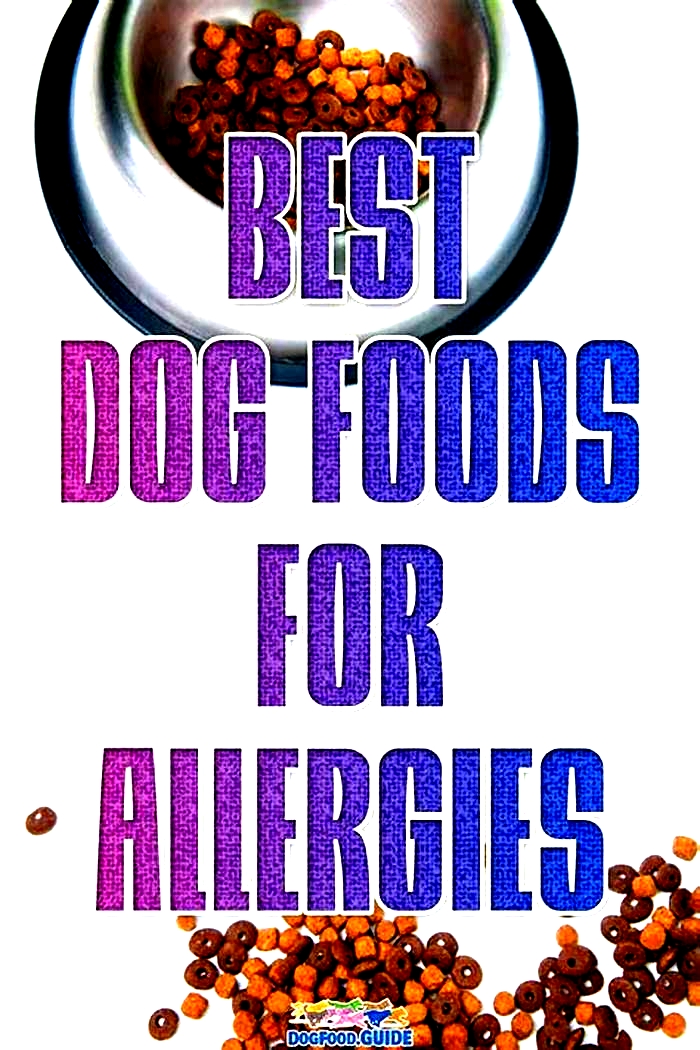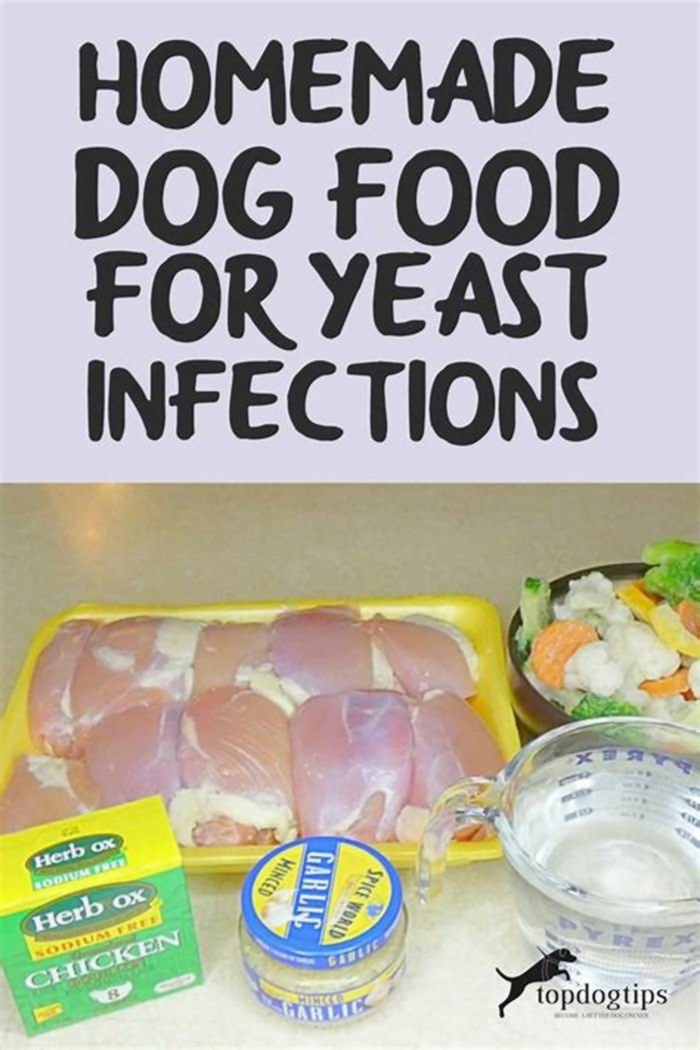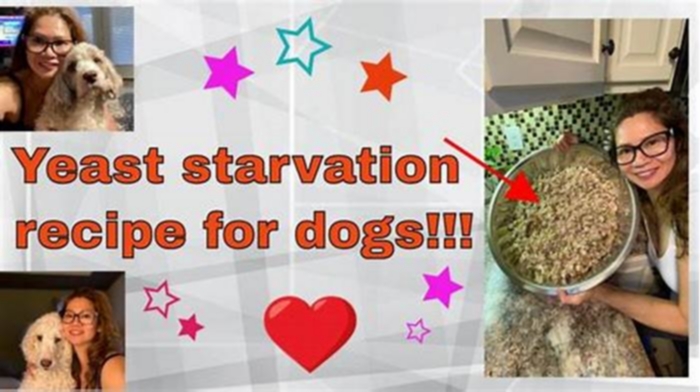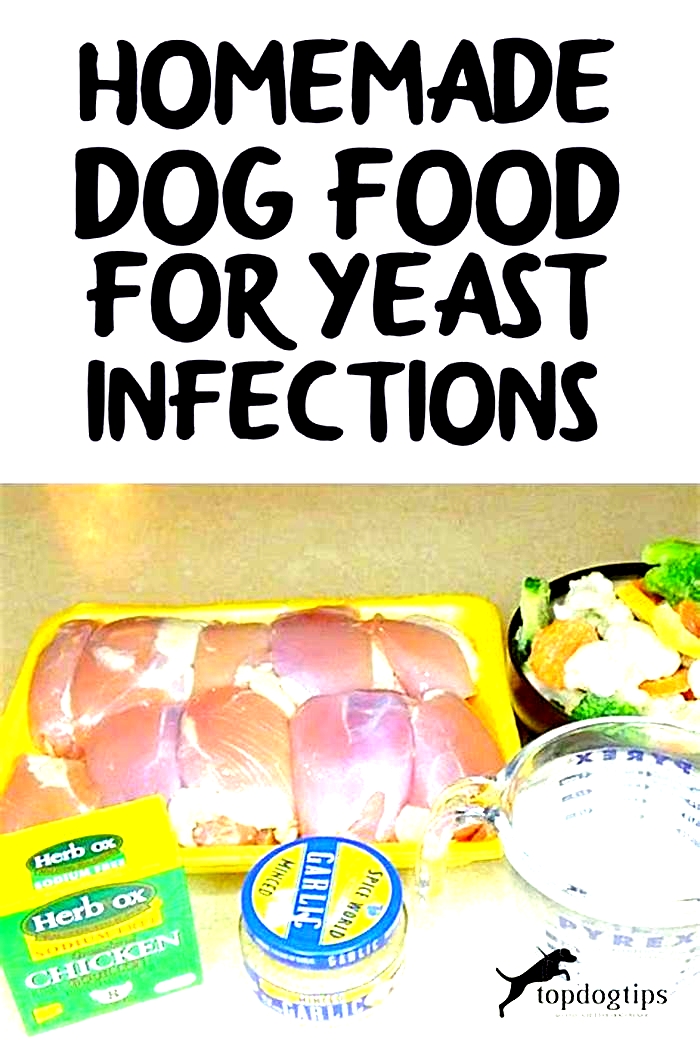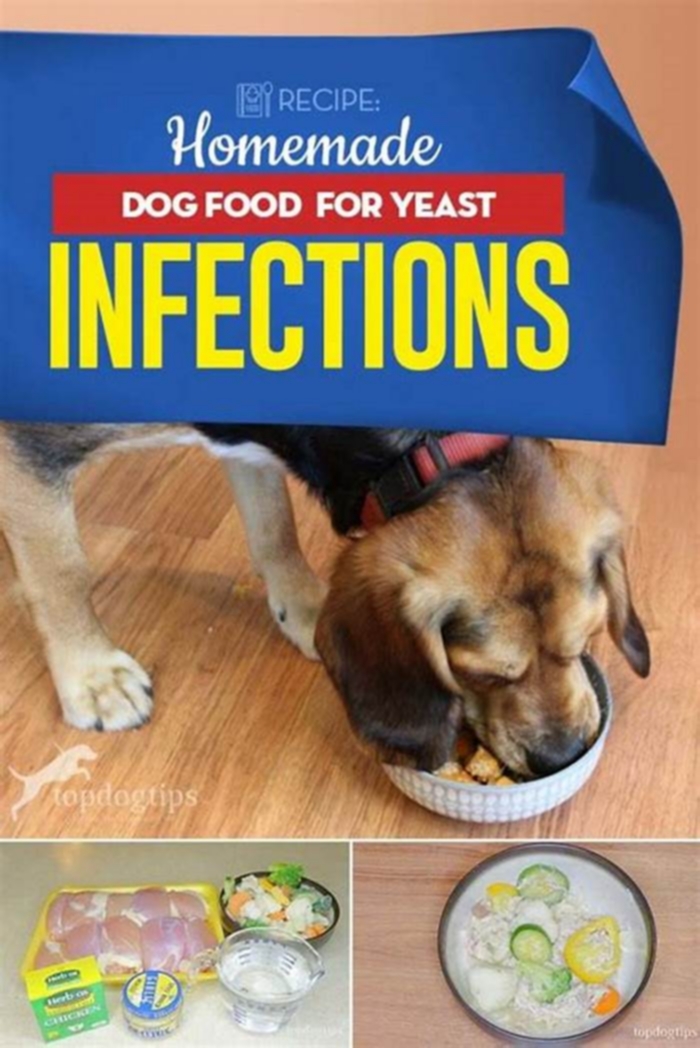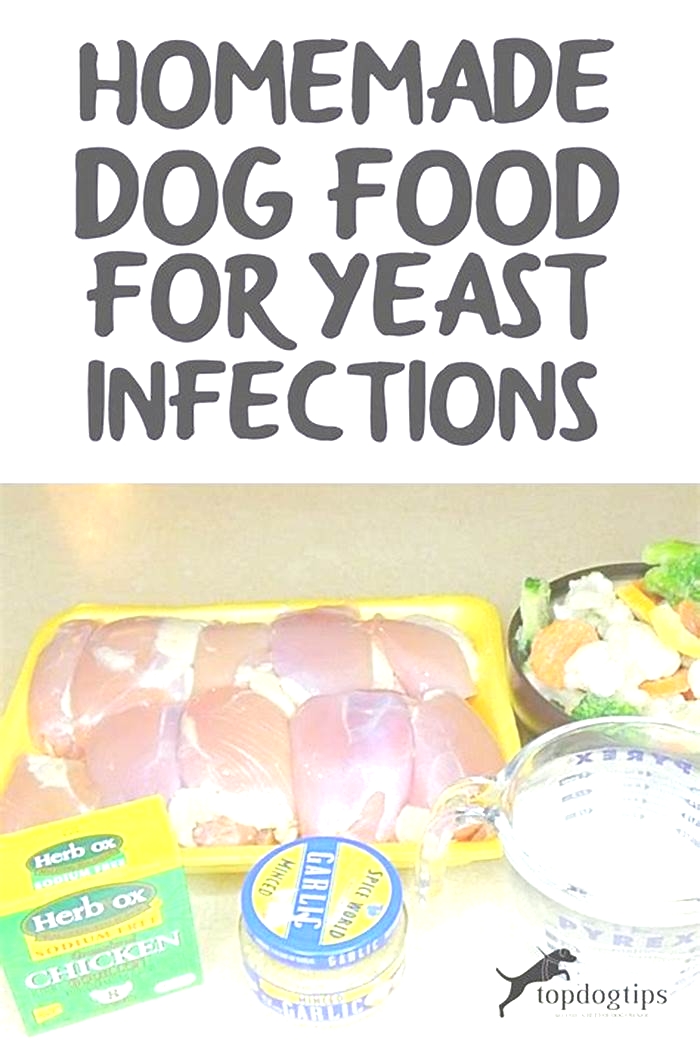homemade dog food yeast infections
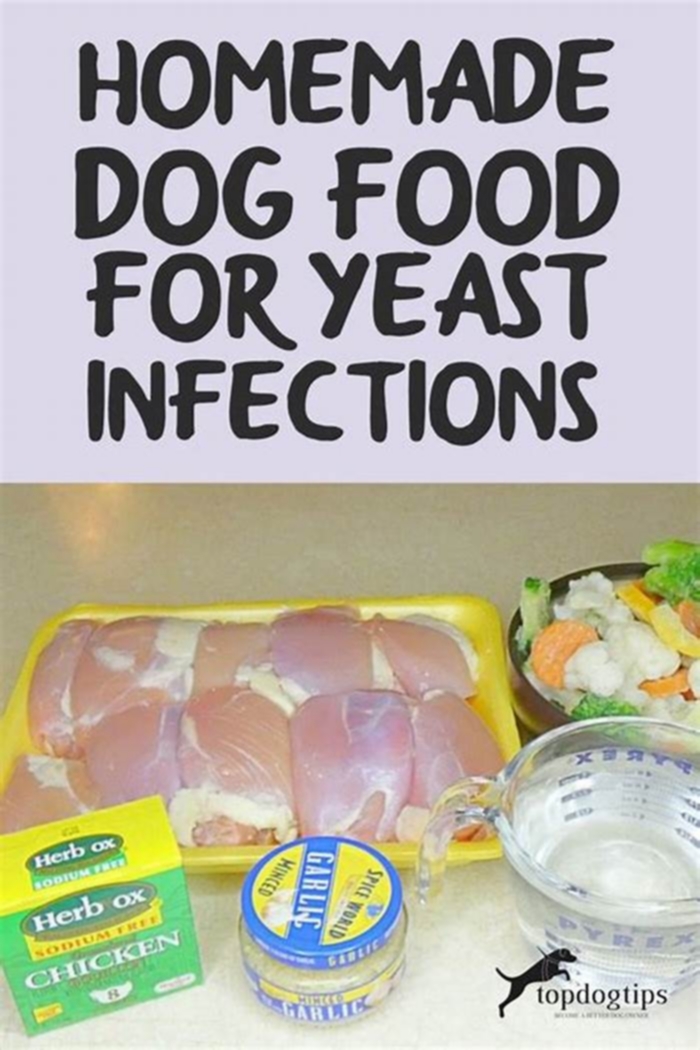
Recipe: Homemade Dog Food for Yeast Infections
Yeast infections are a fairly common skin condition in dogs.
They are typically not something to worry about, but you should seek veterinary care to get the condition cleared up as soon as possible.
What's a yeast infection all about?
This is a skin infection known as yeast dermatitis where 1 particular type of yeast Malassezialives on your dog's skin all the time.
It does not typically cause problems, except for cases of overpopulation.
So today, I came up with this homemade dog food for yeast infections for your Fidos.
This should help clear up skin conditions associated with an overgrowth of yeast.
Let's get cooking, shall we?
 Dog Food for Yeast Infections: Overview
Dog Food for Yeast Infections: Overview
This homemade dog food for yeast infections is also known as a yeast starvation diet. It will help to treat the infection, and then your dog should be gradually returned to his regular diet.
Note: This diet will not provide balanced nutrition for your dog.
If your dog suffers from chronic yeast infections, consult a canine nutritionist about the best yeast starvation to meet his needs.
This recipe may be a good option for your pet, but a canine nutrition expert will likely recommend supplements and/or a multivitamin.
Homemade Dog Food for Yeast Infections Recipe
 Ingredients
Ingredients
- 3 lbs. boneless, skinless chicken thighs
- 2 chicken bouillon cubes
- 2 cloves garlic
- 1 lb. frozen vegetables
Most experts recommend a diet free of grains, potatoes, and yeast if you're trying to make yeast-starvation dog food.
As you can see, this recipe follows those guidelines. However, there is one ingredient that I am often asked about garlic.

Garlic on Dog Food for Yeast Infections
Most pet owners are under the impression that garlic is toxic to dogs.
This is only true for large quantities of garlic.
In moderation,garlic is actually a very beneficial ingredient for canines.
Foods in the genus Allium, like garlic, onions, and leeks were once considered incredibly dangerous for dogs.
But, according to the Journal of Venomous Animals and Toxins including Tropical Diseases:
garlic, on the other hand, is considered to be less toxic and safe for dogs than onion when used in moderation.
Garlic has natural anti-parasitic, anti-fungal, and antibiotic properties.
As I mentioned, this recipe should not be fed for a long period of time.
It will help to treat the infection, and then your dog should be gradually returned to his regular diet.
Directions
Making this homemade dog food for yeast infections is quite simple.
It's a slow cooker recipe, so it's great if you work outside the home and want to prepare homemade food for your pet.
 Step 1: Add the chicken, garlic, bouillon, and water to your slow cooker.
Step 1: Add the chicken, garlic, bouillon, and water to your slow cooker.
Step 2: Cook on low for 6 hours. If you will be out of the house for more than 6 hours, that's okay. Your slow cooker will automatically shut off or switch to a warm' setting after 6 hours.
Step 3: Add the vegetables and cook on low for another 30 minutes. When the homemade dog food for yeast infections is cooled, you can serve it to your dog.
The recommended serving size is about 1/2 cup for every 20 pounds of body weight. You should feed 2 servings per day.
Keep in mind that exceptionally active dogs will require more calories, while less active dogs may not require as many.
You can store leftovers in the refrigerator in an airtight container for up to 6 days.
Do you want Other Options for Dog Food for Yeast Infection? Follow these Rules and Tips
If your dog is prone to yeast infections, then your vet may suggest an anti-yeast diet.
The above dog food recipes are a good starting point, but you can also get creative as long as you know what to include and what to exclude.
Stick to Raw Food
Giving your dog a raw diet is a good choice if he has regular yeast infections. A raw diet is similar to the meat-based diet of your dog's ancestors.
Most importantly for the yeast infection, there will not be processed carbs that will feed the yeast.
Try a Limited-Ingredient Diet
If you don't want to give your pup a raw diet, you can also look for limited-ingredient commercial food.
Because these foods have fewer ingredients, they tend to have fewer low-quality carbs.
Always Minimize Processed Foods
Even if you don't give your dog a raw diet or homemade food, make sure that you stay away from overly-processed foods.
Some ingredients to avoid include excessive starch, high-fructose corn syrup, and corn fillers.
Avoid Natural Sugars
You don't just want to avoid processed sugars and carbs. Dogs with yeast infections should also avoid natural sugars.
Remember that the glucose in the sugar will feed the yeast.
Go Grain-Free
Because carbohydrates fuel yeast infections, dog owners should also strongly consider a grain-free diet.
Prioritize Protein
When creating your pup's new diet, focus on protein. Remember to focus on unprocessed meats.

Dog Food For Yeast Infections: What to Avoid
Common veterinary advice for dogs with yeast infections includes the following list of foods to avoid:
- Bread
- Bacon
- Peanuts
- Pretzels
- Sausage
- Crackers
- Potatoes
- Buttermilk
- Lunch Meat
- Mushrooms
- Gravy or sauce
- Packaged cereal
- Sweet Potatoes or Yams
- Cheese or cottage cheese
- Anything else with grain or sugar
Dog Food For Yeast Infections: What to Include
You can also get creative with a dog food recipe that has the following ingredients, all of which are good for controlling yeast infections in dogs:
If you opt for homemade dog food, always make sure to plan the recipe carefully so your dog gets all the nutrients he needs.
If you haven't made your pup a meal before, start with dog food recipes to get an idea of the proper balance.
What are the Signs of Yeast Infection in Dogs?
If your dog is scratching his ears nonstop and has cracked lips or red, inflamed skin, it could be a sign that it has a yeast infection.
Chewing of the paws is another sign of a yeast infection in dogs, as the yeast can build up between the toes and cause irritation.
Finally, if the red, itchy skin is accompanied by a foul smell, it's very likely that your dog has a yeast infection.
Home remedies may get rid of a yeast infection in dogs, but your veterinarian can also prescribe a topical cream to help treat the condition quickly.
The Role of Pet Foods in Yeast Infections
The environment is not the only factor influencing whether your dog develops a yeast infection; his diet also plays a role.
To survive and grow, yeast needs energy in the form of glucose.
This glucose comes from carbohydrates and starches.
The problem is that many low-quality foods have low-quality carbohydrates, as they are popular, cheap fillers.
These fillers have minimal nutrition but have all the nutrition that yeast needs.
In other words, a low-quality diet can increase the risk of a skin infection or other types of yeast infections.
Feeding your furry friend anti-yeast dog food is a simple way to overcome this challenge. Watching what your dog eats doesn't have to be overwhelming.
While we offer the above recipe, dog owners with less time on their hands can also find commercial options that are right for your dog's diet.
Common Questions About Homemade Yeast Starvation Dog Food
If you still have some doubts about yeast-free dog food, the following information should answer your lingering questions.
What Do You Feed a Dog with a Yeast Infection?
A raw diet is a very popular option for an anti-yeast diet. You can also opt for a partially raw diet.
If you don't have time to make homemade food, consider a commercial homemade diet.
What Food Kills Yeast in Dogs?
Anti-fungal foods for your dog include items with olive leaf, Pau D-Arco, and caprylic acid.
How Do I Reduce My Dog's Yeast Infection?
If your dog is dealing with yeast infections, your vet will likely suggest yeast-free dog food along with topical treatments.
Examples of topical treatments include antifungal creams, shampoos, sprays, and wipes with ketoconazole, miconazole, or chlorhexidine.
Will Yogurt Help My Dog's Yeast Infection?
Yes, yogurt is a good food to include in an anti-yeast diet. This is because of the probiotics, which can fight yeast infections.
For the best results, choose a natural, probiotic yogurt without added sugar.
Dog Food for Yeast Infections: Before You Go
When your dogs are suffering from illnesses or infections, the best way to alleviate pain is to quickly have them assessed by your vet.
But it just doesn't end there.
Your dogs need your support and aftercare, too.
That's when Top Dog Tips steps in.
Hopefully, this dog food recipe for yeast infections can help you get started.
So, if you enjoyed this blog, you might find the following articles helpful, too!
READ NEXT:
WANT TO SHARE THIS

Homemade Dog Food for Yeast Infections: Diet Suggestions and a Recipe
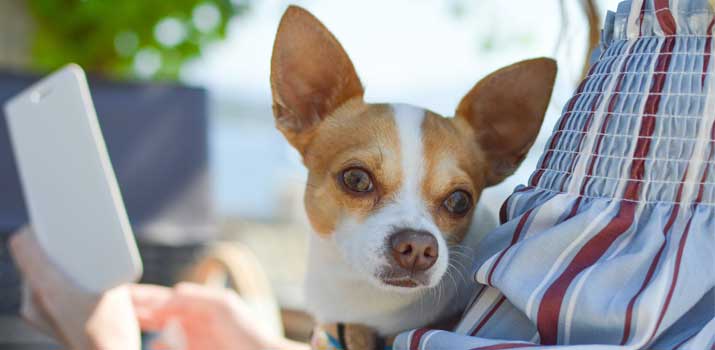
If your dog suffers from frequent yeast infections, you know the struggle they can cause all too well.
Many infections start as nothing more than some skin irritation. However, they can quickly get out of hand. In many cases, they can become a chronic problem that continually plagues dogs for years to come.
Veterinarians will tackle yeast infections in many different ways. They may provide topical creams, anti-fungal skin treatments, and prescription medications.
Experts also agree that dietary changes can make a drastic difference in the frequency of yeast infection breakouts.
Yeast infections can occur for many different reasons. However, what your dog eats might inadvertently feed the unwanted yeast!
By making some dietary changes, you could reduce the frequency of outbreaks and provide some much-needed relief.
Why Yeast Infections Happen
There are many misconceptions about yeast infections. Theyre more common than people think.
Thats because the yeast and fungus that cause these infections are always on the skin!
The yeast is called Malassezia. Its naturally occurring and lives on the skin of many animals. Both you and your dog have it!
Issues arise when the Malassezia yeast becomes abundant. It can get out of control when conditions are just right.
Yeast infections tend to occur in warm and humid conditions. Common infections site include the ears, skin folds, and more.
When water is introduced into the mix, infections proliferate quickly.
But its not just environmental factors that come into play.
How Dog Food Plays a Part in Yeast Buildup
Yeast needs fuel to survive. It has to have a continual supply of energy to spread and grow. What fuel does Malassezia need? The yeast thrives on sugar.
Were not talking about table sugar here. Malassezia utilizes glucose that you get from starches and carbohydrates.
As your body converts carbohydrates into sugars, the yeast takes advantage of it to grow and spread. Before you know it, your dog has a yeast infection.
Unfortunately, low-quality carbs are pretty standard in traditional dog foods. They act as cheap fillers. While they can fill your dog up, they dont offer much in terms of nutritional content.
Theyre essentially empty calories that do nothing but feed the yeast living on their skin!
An anti-yeast diet can change all of that.
A homemade or modified diet aims to deprive the yeast of the food it needs to grow out of control.
You dont have to avoid starches or carbs altogether. But, you can reduce the prevalence of those ingredients in favor of better alternatives.
Ways to Adopt an Anti-Yeast Diet
Making a few dietary changes can make all the difference and put your dog on the path to a life free of uncomfortable yeast infections.
Here are a few suggestions worth considering.
Switch to Raw Food
Raw diets are great for dogs that suffer from yeast infections. Theyre modeled after the meat-based diets that wild dogs and your pups ancestors survived on.
In the wild, dogs didnt eat processed foods filled with carbs. They survived on meat alone!
You can recreate a similar diet and take complete control over what your dog puts into its body.
Stick to wholesome meats and use organs to provide some much-needed vitamins and minerals.
Try Limited Ingredient Commercial Formulas
While a raw diet might be ideal, its not always practical for every dog owner. If thats the case, you can try a limited ingredient commercial diet.
These foods are formulated with as few ingredients as possible. As a result, they contain far fewer carbohydrates.
Most of the nutritional density is devoted to protein, so fillers are the first to go.
Avoid Overly-Processed Products
Super processed foods are, unfortunately, hard to avoid these days. Everything is produced on a massive scale.
As a result, manufacturers turn to processed ingredients and unnecessary additives.
Check your dog foods ingredient list and avoid anything that contains too much processed junk.
Avoid foods that include things like high fructose corn syrup and excessive starch. Corn fillers are cheap and can help with things like preservation and flavor.
However, theyre also awful sources of extra sugar. Avoid heavy processing and stick to natural, limited-ingredient foods that are made in smaller batches when possible.
Ingredients to Avoid
In addition to heavily processed additives, its best to avoid anything that contains natural sugars.
Steer clear of high-starch foods and carb-based recipes. If you see a lot of potatoes and rice in the mix, it means that the food has numerous carbs to convert into sugar.
The same goes for grains. Grain-free recipes are a point of contention among dog owners. Despite all of that, we do know that too many grains can lead to excess blood sugar.
If your dog has a yeast infection problem, grains are the last thing they need.
Ingredients to Look For
Whether you decide to make your dogs food from scratch or buy it as dry kibble, look for wholesome ingredients.
Your dogs diet should be predominantly protein.
Look for wholesome and identifiable meats. Unprocessed foods that are chock-full of probiotics and digestible ingredients are a plus.
Good ingredients ensure that your dogs body takes full advantage of the nutrients food has to offer without the excess sugar conversion to feed yeast.
Homemade Dog Food Recipe for Yeast Infections
Looking to take matters into your own hands? Making your dogs food from scratch lets you make ingredient decisions that benefit their overall health.
Rather than questioning and making guesses, you can know for sure that your meals arent feeding the yeast!
This recipe is simple and contains only a handful of wholesome ingredients.
One ingredient that might come as a surprise is garlic. Garlic is primarily considered to be toxic in the dog community.
While large amounts can cause some severe health problems, its beneficial in moderation.
Garlic contains anti-fungal properties, so adding it to a homemade recipe can do wonders to keep infections at bay.
What Youll Need
- 3 pounds of chicken thighs
- 2 chicken bouillon cubes
- 2 garlic cloves
- 1 pound of mixed frozen vegetables
When choosing the vegetable mix, make sure to select a frozen product that doesnt contain onions or anything else thats harmful to dogs.
Youre already using garlic, so you dont want to overdo things!
Making the Recipe
Start by deboning the chicken and removing the skin. You can also dice the garlic. Then, whip out your slow cooker!
This is a set it and forget it kind of recipe. Once you prepare the ingredients, you can leave the slow cooker to work its magic for several hours.
Place the chicken, garlic, and bouillon cubes into the slow cooker.
Add enough water to cover the ingredients. Set the machine on the lowest setting and let everything cook for about six hours.
After the six-hour mark, add the frozen vegetables and let the food cook for an additional 30 minutes.
Let the food cool completely before feeding your dog. If you have any leftovers, put the food in an airtight container and pop it in the fridge.
Itll be suitable for another six days or so.
Conclusion
Adjusting your dogs diet can make a world of difference. It deprives yeast of the fuel it needs to grow, resulting in fewer infections in the future.
Make these changes gradually. Take some time to transition your pup slowly to avoid any stomach upsets.
Once they adapt to their new diet, your dog will be happier and much healthier!
Also Read:Best Rated Large Breed Puppy Foods

